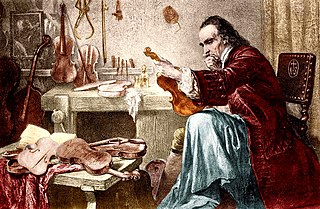
Antonio Stradivari was an Italian luthier and a craftsman of string instruments such as violins, cellos, guitars, violas and harps. The Latinized form of his surname, Stradivarius, as well as the colloquial Strad are terms often used to refer to his instruments. It is estimated that Stradivari produced 1,116 instruments, of which 960 were violins. Around 650 instruments survive, including 450 to 512 violins. His instruments are considered some of the finest ever made, and are extremely valuable collector's items.

A Stradivarius is one of the violins, violas, cellos and other string instruments built by members of the Italian family Stradivari, particularly Antonio Stradivari, during the 17th and 18th centuries. They are considered some of the finest instruments ever made, and are extremely valuable collectors items.

Joshua David Bell is an American violinist and conductor. He plays the Gibson Stradivarius.

BaronArthur Grumiaux was a Belgian violinist, considered by some to have been "one of the few truly great violin virtuosi of the twentieth century". He has been noted for having a "consistently beautiful tone and flawless intonation". English music critic and broadcaster, Edward Greenfield wrote of him that he was "a master virtuoso who consistently refused to make a show of his technical prowess".

Jean-Baptiste Vuillaume was a French luthier, businessman, inventor and winner of many awards. His workshop made over 3,000 instruments.

Matteo Goffriller (1659–1742) was a Venetian luthier, particularly noted for the quality of his cellos. He was active between 1685–1735 and was the founder of the "Venetian School" of luthiers, during a time when Venice was one of the most important centers of musical activity in the world.

Roberto Regazzi is a notable contemporary violin maker and scholar who received his initiation in the craft from Otello Bignami. Regazzi lives and works in Bologna.
Francesco Rugeri, also known as Ruger, Rugier, Rugeri, Ruggeri, Ruggieri, Ruggerius, was the first of an important family of luthiers, the Casa Rugeri in Cremona, Italy. His instruments are masterfully constructed. His violins are inspired by Nicolò Amati's "Grand Amati" pattern. Francesco was the first to develop a smaller cello design, which has become the standard for modern cello dimensions. Today, Rugeri's instruments are nearly as renowned as Nicolò Amati's instruments.
Samuel Zygmuntowicz is a contemporary luthier and is widely regarded as one of the finest violin makers of his generation. He began his instrument making training at age 13, and studied making and restoration under Peter Prier, Carl Becker and René Morel. Since 1985 he has been based in Brooklyn, New York. His early work demonstrates expert skill as a copyist of classic instruments. Later work includes personal models informed by intensive advanced research. Findings from this research have been published in numerous print and digital media. Zygmuntowicz is an active fiddler, playing with several folk music groups. His playing can be heard on the recordings Grand Picnic, and Jump When the Trumpets Blow.
Joseph Henry became one of the most important bowmakers of the golden era of French bowmaking, working and collaborating with his master and employer Dominique Peccatte and business partner Pierre Simon

Hottinger Collection – formed in New York City by Henry Hottinger.

Nicola Amati, Nicolò Amati or Nicolao Amati was an Italian master luthier from Cremona, Italy. Amati is one of the most well-known luthiers from the Casa Amati. He was the teacher of illustrious Cremonese School luthiers such as Andrea Guarneri and Giovanni Battista Rogeri. While no clear documentation exists for their being apprentices in his shop, Amati may also have apprenticed Antonio Stradivari, Francesco Rugeri, and Jacob Stainer, as their work is heavily influenced by Amati.
Nancy Zhou is a Chinese-American classical violinist. She has performed as a soloist in recital and with orchestras throughout the world. Zhou has been a prizewinner in several major competitions, including first prizes in the 2018 Shanghai Isaac Stern International Violin Competition and the 2018 International Music Competition Harbin.
The Universal Dictionary of Violin & Bow Makers is a widely cited reference work providing information on approximately 9,000 violin makers. The work is based on the extensive notes of violinist and composer William Henley (1874-1957). Henley had in his youth studied with August Wilhelmj, and later became a professor of composition and principal of the violin at the Royal Academy in London. Having played violins from many manufacturers, Henley sought to compile a comprehensive list evaluating violin and bow makers. After Henley's death in 1957, dealer Cyril Woodcock (1897–1980) completed and published the work based on Henley's unfinished notes. The work was first published in five volumes in 1959 and 1960, and republished in a single volume in 1973.
Tommaso Balestrieri was an Italian luthier in Mantua, primarily active from 1750s to 1780s.

Vincenzo Rugeri, was an Italian luthier of string instruments such as violins, cellos, and, violas in Cremona, Italy. His instruments are noted for their craftsmanship and tone quality. Vincenzo came from a distinguished family of luthiers, the first of whom was his father, Francesco Rugeri. Despite the local tradition of artisan families laboring together through generations, Vincenzo left the family shop and set up a successful shop of his own in the center of Cremona. Vincenzo was the third son of luthier Francesco Rugeri. Vincenzo's work, like Francesco's, is influenced by Nicolò Amati's Grand Pattern model, however Vincenzo's work was distinguished from his father's by utilizing a lower arch inspired by Antonio Stradivari. An analysis of the body of his work reveals that the quality of Vincenzo's instruments is remarkable, perhaps even more so than his father's. Vincenzo's instruments, though less numerous, are valued at least equal to those of his father. A violin by Vincenzo Rugeri realized $502,320 on October 3, 2011 at Brompton's Auctions in London. Carlo Bergonzi was a distinguished apprentice of Vincenzo Rugeri.

Horace William Petherick (1839-1919) was an artist and illustrator, a violin connoisseur, and a writer. As an artist, four of his works are in public collections in the UK; as an illustrator, he illustrated over 100 books, some of which are still in print, and his work can be found in digital collections at the British Library, the Osborne Collection of Early Children's Books, and the Baldwin Library of Historical Children's Literature; as a violin connoisseur, he owned both a Stradivarius and a del Gesù; and as an author, three of his books are still in print.
Barbara Buntrock is a German violist and music educator.
Timothy Ridout is a British violist and 1st Prizewinner of the prestigious Lionel Tertis International Viola Competition.










